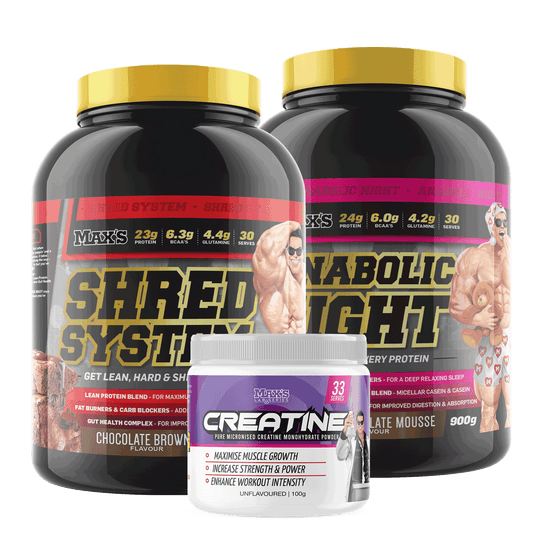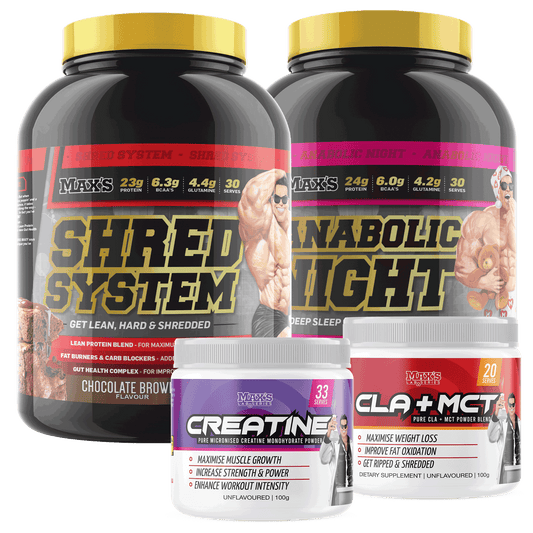BOOST LEAN MUSCLE GROWTH WITH OUR AUSSIE-MADE SLOW-RELEASE PROTEIN POWDER
Slow-release or time-release protein is slow to digest and ideal for muscle growth and bodybuilding. With slow-releasing protein, amino acid building blocks are released for up to 12 hours, enabling long workouts and sustainable recovery. Dairy-derived casein is the most widely used and effective source of slow-release protein, and it takes longer to absorb in the gut than whey protein isolate and other protein sources.
MAX's is a leading specialist in slow-releasing protein supplements that promote muscle growth and repair. Whether you want to reduce your fat percentage, increase your mass, or get the ultimate shredded physique, our 100% Aussie-made slow-release protein powders are a great way to supercharge your diet.
WHY USE CASEIN PROTEIN & SLOW DIGESTING PROTEIN SUPPLEMENTS?
Protein is critical for various physical functions, including the internal transportation of nutrients, cell repair, and promoting cell growth in muscles and tissue. While fast-release protein sources like red meat and other foods function as a complete protein source, supplements are a great way to access slow-releasing protein in a concentrated, easy-to-take and slow-digesting protein source.
THE BENEFITS OF SLOW RELEASE PROTEIN
- Sustained Muscle Protein Synthesis: Slow-release proteins provide a continuous supply of amino acids to the muscles over an extended period (up to 12 hours). This sustained availability of essential amino acids supports muscle protein synthesis, which is crucial for muscle repair, recovery, and growth.
- Anti-Catabolic Effect: Casein protein and other time-release proteins are anti-catabolic, which can reduce protein breakdown within the body. With a much slower digestion rate than other protein sources, they provide a sustained supply of amino acids to muscle cells during and after your workout.
- Extended Anabolic Window: Slow-release proteins extend the anabolic window, the period after exercise when muscle cells are most receptive to nutrients for growth and repair. By providing a steady stream of amino acids, they optimise this window, maximising potential muscle gains.
- Satiety and Appetite Control: Slow-release proteins, due to their prolonged digestion rate, can help promote a feeling of fullness and satiety. This can benefit individuals trying to manage their weight or adhere to a controlled calorie intake.
- Nighttime Recovery: Slow-release proteins are especially useful before bedtime. They provide a continuous supply of amino acids during sleep when the body undergoes restorative processes and muscle repair.
-
Supporting Long Workouts: Slow-release proteins can provide a sustained energy source for athletes or individuals engaged in prolonged workouts or endurance training, helping to maintain muscle performance and prevent muscle fatigue.
-
Muscle Preservation during Fasting: During periods of fasting or calorie restriction, slow-release proteins can help preserve muscle mass by providing a constant supply of amino acids and preventing muscle breakdown for energy.
-
Enhanced Nitrogen Retention: Slow-release proteins contribute to a positive nitrogen balance in the body, indicating a state where protein synthesis exceeds protein breakdown. This promotes muscle growth and overall muscle health.
- Complementary to Fast-Acting Proteins: Slow-release proteins can be combined with fast-release protein sources like whey to optimise muscle protein synthesis. Consuming both types of proteins in a post-workout shake, for example, provides an initial rapid surge of amino acids from whey, followed by a sustained release from casein, creating an ideal environment for muscle repair and growth.
WHO SHOULD USE SLOW RELEASE PROTEIN
-
Athletes and Endurance Trainers: Slow-release protein supplements can benefit athletes engaged in intense training, endurance sports, or long-duration exercises. These products help sustain energy levels during extended workouts, support muscle recovery, and reduce muscle breakdown, promoting better performance and reducing the risk of overtraining.
-
Bodybuilders and Strength Athletes: Slow-release protein can be highly advantageous for bodybuilders and strength athletes who require a continuous supply of amino acids to support muscle repair and growth. By extending the anabolic window, slow-release proteins aid in maximising muscle gains, especially when used as part of a post-workout recovery strategy.
-
Fitness Enthusiasts: Whether engaging in weight training, HIIT (High-Intensity Interval Training), or other forms of exercise, fitness enthusiasts can benefit from slow-release protein supplements. These products provide sustained nourishment to muscles, improving workout performance, aiding recovery, and contributing to muscle toning and development.
-
Weight Management Seekers: Slow-release protein supplements can aid in weight management efforts by promoting satiety and controlling appetite. By providing a feeling of fullness, these products can help individuals manage calorie intake and reduce the likelihood of overeating or snacking on unhealthy foods.
-
Nighttime Recovery and Muscle Preservation: Slow-release proteins are particularly valuable before bedtime as they sustain amino acids' release during sleep. This supports muscle recovery and helps prevent muscle breakdown, making them ideal for individuals looking to preserve muscle mass during periods of fasting, such as overnight.
THE SCIENCE BEHIND SLOW-RELEASE PROTEIN & MUSCLE PROTEIN SYNTHESIS
Slow-release proteins aid muscle protein synthesis through their unique digestion and absorption characteristics, which provide a sustained release of amino acids into the bloodstream. This prolonged availability of amino acids has several effects that contribute to muscle protein synthesis:
-
Continuous Supply of Amino Acids: Slow-release proteins, like casein, form a gel-like substance in the stomach, leading to a slower digestion rate than other protein sources. As a result, amino acids are released gradually over an extended period (up to 12 hours). This continuous supply of amino acids provides a constant source of building blocks for muscle repair and growth.
-
Extended Anabolic Window: The anabolic window is the period after exercise when muscle cells are most receptive to nutrients for repair and growth. Slow-release proteins extend this window, ensuring that muscles receive a steady stream of amino acids, even hours after the workout. This allows continued muscle protein synthesis during the recovery phase.
-
Reduction of Muscle Protein Breakdown: Slow-release proteins, especially casein, possess anti-catabolic properties. They help reduce muscle protein breakdown, especially during fasting periods such as overnight sleep. Minimising muscle breakdown makes more amino acids available for muscle protein synthesis.
-
Increased Muscle Protein Accretion: Slow-release proteins have led to greater overall protein accretion (net protein gain) than fast-acting proteins like whey. This increased protein accretion is associated with enhanced muscle protein synthesis and improved muscle recovery and growth.
- Prolonged Amino Acid Elevations: Slow-release proteins sustain elevated blood amino acid levels for an extended period, which has been linked to a more prolonged anabolic response in muscles. This extended period of elevated amino acids supports muscle protein synthesis over a longer duration.
HOW TO USE SLOW-RELEASE PROTEIN
Here’s a general guide to using slow-release protein powder. If you’re unsure which protein is best for you or you want some advice, please feel free to contact us.
BEFORE YOU START
Calculate your protein requirements before adding any supplement to your diet based on your body weight, activity level, fitness goals, and overall health. General recommendations suggest consuming around 0.8 to 1.2 grams of protein per kilogram of body weight per day for most individuals. However, athletes and those engaged in intense training may need higher amounts, ranging from 1.2 to 2.2 grams per kilogram of body weight.
WHEN TO CONSUME SLOW-RELEASING PROTEIN
-
Pre-Workout: Consuming slow-release protein before a workout can be beneficial, especially for prolonged or intense exercise sessions. This helps provide a sustained source of amino acids during your workout, preventing muscle breakdown and supporting performance. Consider having a slow-release protein shake or protein bar around 30 minutes to 1 hour before your workout.
-
Post-Workout: While slow-release proteins are not the primary choice for immediate post-workout nutrition, they can still be beneficial. To optimise muscle recovery, it's generally recommended to combine slow-release protein with a fast-acting protein source, like whey protein. This combination provides both quick and sustained amino acid release.
-
Nighttime Use: Slow-release proteins are particularly useful before bedtime. They offer a continuous supply of amino acids during sleep, promoting muscle recovery and reducing muscle breakdown during overnight fasting. We highly recommend MAX’S Anabolic Night slow-release protein blend, which contains additional muscle recovery nutrients and sleep-aiding herbs.
-
Between Meals: Slow-release proteins can be a great option for satisfying hunger and maintaining steady energy levels between meals. If you have long periods between meals or snacks, consider consuming a slow-release protein source to curb hunger and support muscle health.
HOW MUCH DO I NEED?
Dosage recommendations vary depending on body weight, activity level, and fitness goals. Aim for 20-40 grams of slow-release protein per serving as a general guideline. Adjust serving size to your protein needs and total daily protein intake.
Remember, everyone's nutritional needs are different. Individualise your protein intake and supplement usage based on your specific goals, preferences, and lifestyle. If you have any medical conditions or concerns, consult a healthcare or nutrition professional before significantly changing your diet or supplement regimen.
OTHER FAQS
Can slow-release protein help weight loss?
Yes — slow-releasing protein can support weight loss goals as part of a calorie deficit. It helps keep you fuller for longer, reducing the temptation to snack and assisting with appetite control throughout the day or night.
Is micellar casein suitable as a meal replacement?
While not a complete meal replacement, micellar casein can supplement your diet when you need extra protein between meals or before bed. It's especially helpful if you manage your calorie intake and maintain muscle while losing fat.
When is the best time to take slow-releasing protein?
The best time to take slow-releasing protein is at night, just before bed. Its gradual absorption supports muscle recovery and growth during sleep. However, it can also be taken during the day if there are long gaps between meals.
How should I store slow-release protein powder?
To maintain freshness and quality, store your protein in a dry place, away from direct sunlight. Always reseal the packaging tightly after use.
Does slow-release protein powder contain any allergens?
Yes, MAX’s micellar casein contains milk and should be avoided by individuals with dairy allergies or lactose intolerance.
SPECIALISTS IN SLOW-RELEASING PROTEIN POWDER
MAX's specialises in slow-release protein products that deliver time after time. Our protein bars, snacks, and supplements are delicious, affordable, and convenient. We offer our slow-release protein sources as affordable bulk packs or individual product items for convenient protein hits.
If you're looking for maximum results and relentless impact, MAX's protein products are the perfect boost to any diet.






